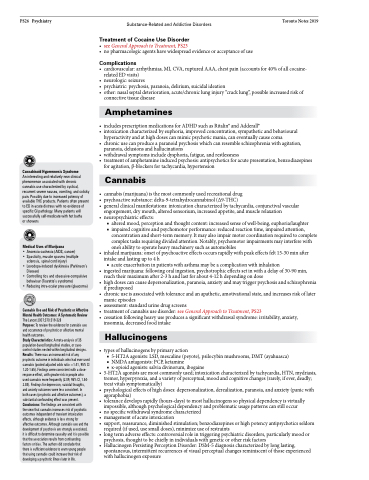Page 1190 - TNFlipTest
P. 1190
PS26 Psychiatry
Substance-Related and Addictive Disorders Toronto Notes 2019
Treatment of Cocaine Use Disorder
• seeGeneralApproachtoTreatment,PS23
• nopharmacologicagentshavewidespreadevidenceoracceptanceofuse
Complications
• cardiovascular:arrhythmias,MI,CVA,rupturedAAA,chestpain(accountsfor40%ofallcocaine- related ED visits)
• neurologic: seizures
• psychiatric: psychosis, paranoia, delirium, suicidal ideation
• other:nasalseptaldeterioration,acute/chroniclunginjury“cracklung”,possibleincreasedriskof
connective tissue disease
Amphetamines
• includesprescriptionmedicationsforADHDsuchasRitalin®andAdderall®
• intoxicationcharacterizedbyeuphoria,improvedconcentration,sympatheticandbehavioural
hyperactivity and at high doses can mimic psychotic mania, can eventually cause coma
• chronicusecanproduceaparanoidpsychosiswhichcanresembleschizophreniawithagitation,
paranoia, delusions and hallucinations
• withdrawalsymptomsincludedysphoria,fatigue,andrestlessness
• treatmentofamphetamineinducedpsychosis:antipsychoticsforacutepresentation,benzodiazepines
for agitation, β-blockers for tachycardia, hypertension
Cannabis
• cannabis(marijuana)isthemostcommonlyusedrecreationaldrug
• psychoactivesubstance:delta-9-tetrahydrocannabinol(Δ9-THC)
• general clinical manifestations: intoxication characterized by tachycardia, conjunctival vascular
engorgement, dry mouth, altered sensorium, increased appetite, and muscle relaxation • neuropsychiatriceffects:
■ altered mood, perception and thought content: increased sense of well-being, euphoria/laughter ■ impaired cognitive and psychomotor performance: reduced reaction time, impaired attention,
concentration and short-term memory. It may also impair motor coordination required to complete complex tasks requiring divided attention. Notably, psychomotor impairments may interfere with one’s ability to operate heavy machinery such as automobiles
• inhaledmarijuana:onsetofpsychoactiveeffectsoccursrapidlywithpeakeffectsfelt15-30minafter intake and lasting up to 4 h
■ acute exacerbation in patients with asthma may be a complication with inhalation
• ingested marijuana: following oral ingestion, psychotrophic effects set in with a delay of 30-90 min,
reach their maximum after 2-3 h and last for about 4-12 h depending on dose
• highdosescancausedepersonalization,paranoia,anxietyandmaytriggerpsychosisandschizophrenia
if predisposed
• chronicuseisassociatedwithtoleranceandanapathetic,amotivationalstate,andincreasesriskoflater
manic episodes
• assessment:standardurinedrugscreens
• treatmentofcannabisusedisorder:seeGeneralApproachtoTreatment,PS23
• cessationfollowingheavyuseproducesasignificantwithdrawalsyndrome:irritability,anxiety,
insomnia, decreased food intake
Hallucinogens
• typesofhallucinogensbyprimaryaction
■ 5-HT2A agonists: LSD, mescaline (peyote), psilocybin mushrooms, DMT (ayahuasca) ■ NMDA antagonists: PCP, ketamine
■ κ-opioid agonists: salvia divinorum, ibogaine
• 5-HT2Aagonistsaremostcommonlyused;intoxicationcharacterizedbytachycardia,HTN,mydriasis, tremor, hyperpyrexia, and a variety of perceptual, mood and cognitive changes (rarely, if ever, deadly; treat vitals symptomatically)
• psychological effects of high doses: depersonalization, derealization, paranoia, and anxiety (panic with agoraphobia)
• tolerancedevelopsrapidly(hours-days)tomosthallucinogenssophysicaldependencyisvirtually impossible, although psychological dependency and problematic usage patterns can still occur
• nospecificwithdrawalsyndromecharacterized
• managementofacuteintoxication
• support,reassurance,diminishedstimulation;benzodiazepinesorhighpotencyantipsychoticsseldom
required (if used, use small doses), minimize use of restraints
• long term adverse effects: controversial role in triggering psychiatric disorders, particularly mood or
psychosis, thought to be chiefly in individuals with genetic or other risk factors
• HallucinogenPersistingPerceptionDisorder:DSM-5diagnosischaracterizedbylonglasting,
spontaneous, intermittent recurrences of visual perceptual changes reminiscent of those experienced with hallucinogen exposure
Cannabinoid Hyperemesis Syndrome
An interesting and relatively new clinical phenomenon associated with chronic cannabis use characterized by cyclical, recurrent severe nausea, vomiting, and colicky pain. Possibly due to increased potency of available THC products. Patients often present to ED in acute distress with no evidence of specific GI pathology. Many patients will successfully self-medicate with hot baths
or showers
Medical Uses of Marijuana
• Anorexia-cachexia (AIDS, cancer)
• Spasticity, muscle spasms (multiple
sclerosis, spinal cord injury)
• Levodopa-induced dyskinesia (Parkinson’s
Disease)
• Controlling tics and obsessive-compulsive
behaviour (Tourette’s syndrome)
• Reducing intra-ocular pressure (glaucoma)
Cannabis Use and Risk of Psychotic or Affective Mental Health Outcomes: A Systematic Review The Lancet 2007;370:319-328
Purpose: To review the evidence for cannabis use and occurrence of psychotic or affective mental health outcomes.
Study Characteristics: A meta-analysis of 35 population-based longitudinal studies, or case- control studies nested within longitudinal designs. Results: There was an increased risk of any psychotic outcome in individuals who had ever used cannabis (pooled adjusted odds ratio =1.41, 95% CI 1.20-1.65). Findings were consistent with a dose- response effect, with greater risk in people who used cannabis more frequently (2.09, 95% CI, 1.54- 2.84). Findings for depression, suicidal thoughts, and anxiety outcomes were less consistent. In
both cases (psychotic and affective outcomes), a substantial confounding effect was present. Conclusions: The findings are consistent with
the view that cannabis increases risk of psychotic outcomes independent of transient intoxication effects, although evidence is less strong for affective outcomes. Although cannabis use and the development of psychosis are strongly associated, it is difficult to determine causality and it is possible that the association results from confounding factors or bias. The authors did conclude that
there is sufficient evidence to warn young people that using cannabis could increase their risk of developing a psychotic illness later in life.


